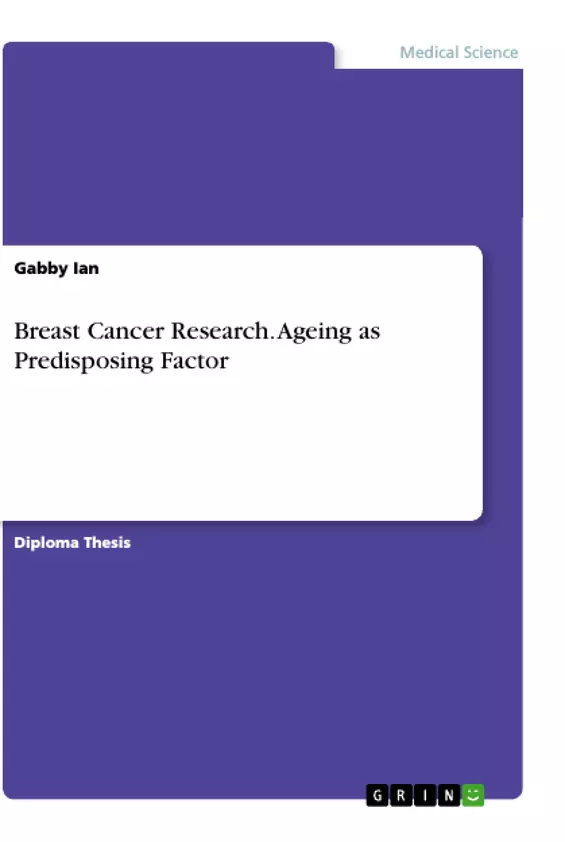This work investigates whether age is among the predisposing factors for breast cancer. Breast cancer is heterogeneous malignant cells whose specific age profiles exponentially increases until menopause after which it rises gently slowly thereby reflecting the superimposition of the early and late onset rates of breast cancer. The early onset breast cancers represent mainly the untimely life transforming or inherited consequences on the undeveloped epithelium, while late-onset breast cancers in most cases are likely to follow an extended exposure to supporting stimulus of vulnerable epithelium, which has botched to age normally. Biomarker studies and clinical observations indicates that the latter staged breast cancer types often develop slowly and are less biologically aggressive compared to the early staged breast cancers despite being under the control of hormone receptors such as growth factor receptor abbreviated as (HER2) and estrogen receptor (ER), expressions hence supporting the conclusion that breast cancer biology is age dependent.
Approximately twelve percent of women across the globe in the current society are annually affected by breast cancer. Moreover, while breast cancer incidence increases with age advancement, patients of younger age at diagnosis are largely associated with increase in the mortality rate. This research discusses most of the age-related factors, which affect the identification or diagnosis, treatment, and management of breast cancer incidence; examining main concepts and exploring vital areas, which calls for additional research. Ageing as a predisposing factor for breast cancer will be examined in connection to diagnosis and treatment with special reference to nodal status, hormone factors, breast cancer subtypes and genetic status. Further, although narrowly, the study will also touch on the future expectations of breast cancer identification and treatment through examination of some rising potential technologies and breast cancer tests like the miRNA.
Inhaltsverzeichnis (Table of Contents)
- Abstract
- Introduction
- Literature Review Related to the Topic
- Lifetime Risks and Incidence of Breast Cancer by Age and Molecular Subtype
- Genetics and Breast Cancer Risks with Age
- Prognosis
- The length of menstrual cycle and the Age at menarche
- Age at Menopause
- microRNAs and breast cancer
- Methodology
- Case 1: A Meta-analysis and Systematic Review of the Risk Factors for Breast Cancer for Women of between 40 and 60 Years
- Case 2: A Vivid Analysis of the Progesterone Receptor Negative, Estrogen Receptor Negative, and HER2 Negative Invasive Breast Cancers or rather the Triple Negative Phenotypes
- Results
- Discussion
- Limitations
- Conclusion
- Recommendations
Zielsetzung und Themenschwerpunkte (Objectives and Key Themes)
This research aims to investigate whether age is a predisposing factor for breast cancer. It explores the relationship between age and breast cancer incidence, diagnosis, treatment, and management, examining the influence of age on the biology of the disease. Additionally, the study delves into the potential of emerging technologies and tests, like microRNAs, in improving breast cancer identification and treatment.
- Age as a predisposing factor for breast cancer
- Influence of age on breast cancer incidence, diagnosis, and treatment
- Biology of breast cancer and its age-dependent characteristics
- Role of hormone receptors and genetic factors in breast cancer development
- Emerging technologies and tests for breast cancer identification and treatment
Zusammenfassung der Kapitel (Chapter Summaries)
The introduction provides an overview of breast cancer, its prevalence, and the significance of age as a risk factor. The literature review extensively discusses the lifetime risks and incidence of breast cancer across different age groups, highlighting the impact of age on various molecular subtypes. It also explores the role of genetics, prognosis, menstrual cycle, menopause, and microRNAs in relation to breast cancer and age. The methodology section outlines the research approach, including a meta-analysis and systematic review of risk factors for breast cancer in women between 40 and 60 years and a detailed analysis of triple-negative breast cancer phenotypes. The results and discussion sections present findings and interpretations, while the limitations acknowledge the study's constraints.
Schlüsselwörter (Keywords)
The key terms and concepts of the work include breast cancer, age, predisposing factors, incidence, diagnosis, treatment, management, hormone receptors, genetics, microRNAs, triple-negative breast cancer, molecular subtypes, and emerging technologies.
- Quote paper
- Gabby Ian (Author), 2018, Breast Cancer Research. Ageing as Predisposing Factor, Munich, GRIN Verlag, https://www.grin.com/document/1045118



